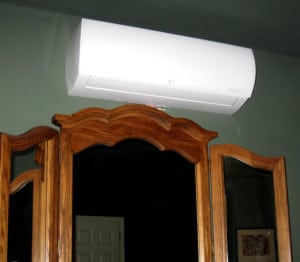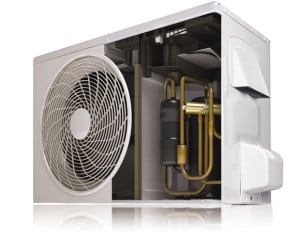Dear Jim: We added a room, but our central air conditioner doesn’t cool it well. Our second-floor master bedroom also does not stay cool. Does it make more sense to install a window air conditioner or a mini-split system? — Kyle F.
Dear Kyle: This is a common problem, especially for second-floor rooms. Cool air is denser than warm air, so it tends to drop to the first floor through cracks, gaps and the stairs. Also, second-floor ceilings are exposed to the hot underside of the roof and tend to stay warm well into the evening.

Whether you install a mini-split heat pump or a window air conditioner depends on what you need and want from the unit. Most people install a window air conditioner to provide extra cooling in a room at a low initial cost. Energy efficiency is not the primary concern. Mini-split heat pumps offer many bonus features (heating and cooling, quiet operation, flexible installation and control) and increased efficiency but at a higher cost.
A window unit generally sells for less than $300; mini-splits can run to more than $1,000, plus the cost of installation. Also, unlike a window unit, mini-splits can’t be moved once installed.
A window air conditioner has all its components — compressor, air circulation fan, condenser fan, etc. — in the cabinet mounted in the window. Though it is insulated against heat flow and sound, it still is not ideal for energy efficiency. The newest ones are fairly quiet but still may be annoying in a bedroom at night. When it’s not running, more outdoor road noise can be heard.
 A mini-split system is similar to a central air conditioner or heat pump, with the condenser fan, coils and compressor in an outdoor unit, which is flat and small.
A mini-split system is similar to a central air conditioner or heat pump, with the condenser fan, coils and compressor in an outdoor unit, which is flat and small.
Some models allow the outdoor unit to be placed up to 100 feet from the room or group of rooms to be cooled or heated. This virtually eliminates indoor noise pollution from these components.
Instead of having the indoor cooling coil in an air-duct system as with your existing central air conditioner, the coil is mounted in a fan unit on the wall or ceiling of the room. It’s connected to the outdoor unit by refrigerant and electric lines. Only a 3-inch-diameter hole needs to be cut through the wall, and the condensate drain from the evaporator coils can go out through the same hole.
Mini-split systems can also be used to cool an entire house by installing indoor wall units in several rooms. The conditioned air will naturally circulate throughout the house. This is commonly done in houses using baseboard electric or hydronic heat, which lack a duct system. Installing a duct system for central air conditioning in an existing two-story house can be an expensive project.
In addition to the high SEER rating, installing a mini-split unit allows for zone cooling of your house, which can also lower your electric bill. In my case, there’s no need to keep the downstairs cool all night when I’m sleeping in the upstairs bedroom. My mini-split system allows me to set the central heat pump thermostat higher at night so it runs very little. This provides substantial electricity savings.
Inverter compressor technology is the newest and most efficient trend in air conditioning. The compressor runs at variable speeds to provide for variable cooling output. Once the room cools down to the thermostat setting, the inverter compressor speed slows to keep the room at that temperature.
The mini-split’s remote control has several modes of operation, including a dehumidification setting for the summer, which slows down the fan speed so the indoor air is dehumidified more than it is cooled. This is ideal for allergy-sufferers who are sensitive to high humidity but don’t want a cold room.
For more information, visit energy.gov/energysaver/ articles/ductless-mini-split-heat-pumps and www.energystar.gov.
These companies offer mini-split air conditioners/heat pumps: Carrier, 800-227-7437, www.carrier.com; Fujitsu General, 888-888-3424, www.fujitsugeneral.com; LG, 888-865-3026, www.lg-dfs.com; Mitsubishi Electric, 800-433-4822, www.mehvac.com; and Samsung, 888-699-6067, www.quietside.com.



